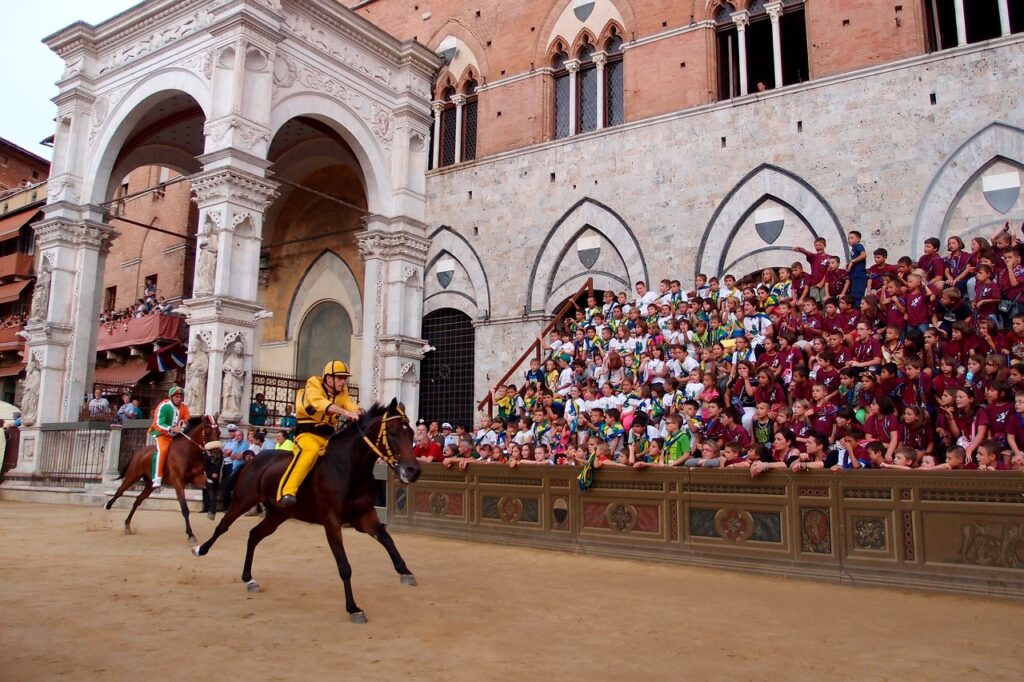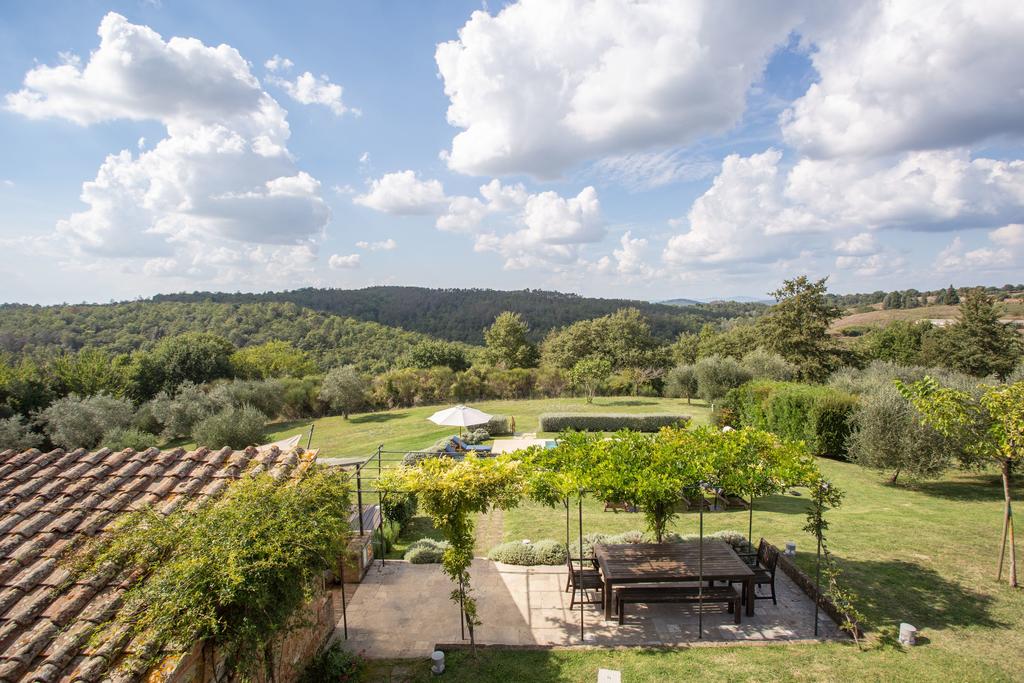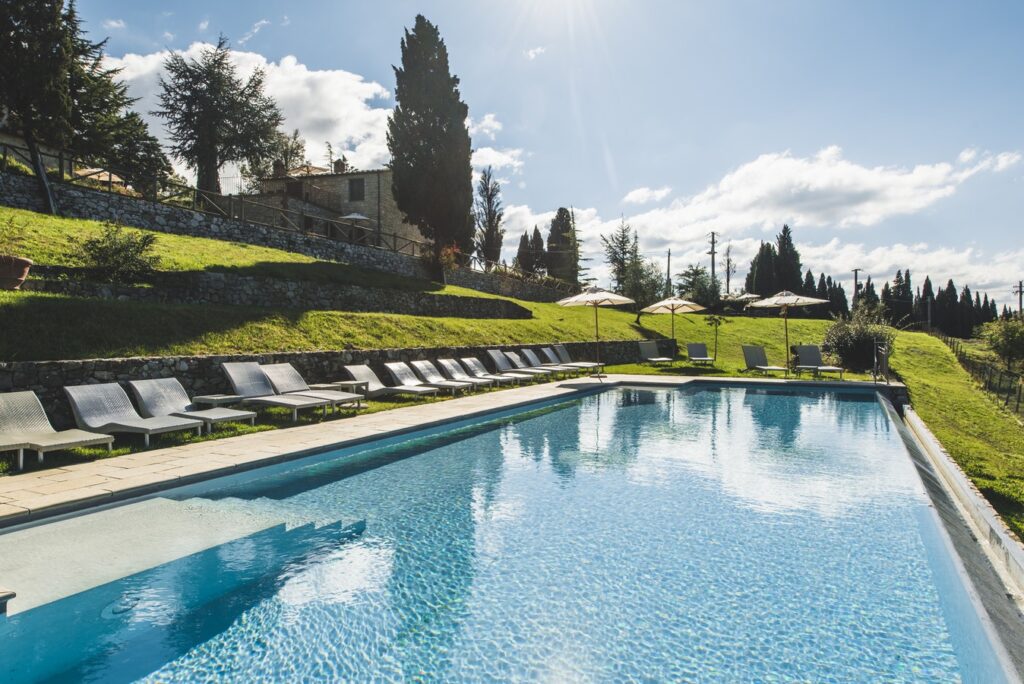Complete guide to the Siena Palio
History of the Siena Palio
The history of the Siena palio goes back centuries. As far back as the 6th century AD there are reports of horse races taking place in the city. However, it became much more common from the 14th century onwards. Of course, over time the nature and rules of events have changed. We do know for sure that a palio was first held in Siena in 1482 and was a civic celebration. However, the current course was formally established in 1659 and the palio has been held twice a year since 1701 with the exception of during wartimes or the more recent COVID pandemic.
When does the Siena Palio take place
The Siena palio takes place twice a year on 2 July – the Palio of Provenzano – and 16 August – the Palio of the Assumption.
What is the Siena Palio
Siena is split into different wards (contrade), each of which has its own parish church, fountain and piazza. Each resident of Siena belongs to one of these contrade. Historically, there would have been fifty-nine contrade but these days there are only seventeen, each with its own mascot namely Eagle, Snail, Wave, Panther, Forest, Tortoise, Owl, Unicorn, Shell, Tower, Ram, Caterpillar, Dragon, Giraffe, Porcupine, She-Wolf and the Goose. Each of these has a distinctive flag. These colourful flags are flown all year round in their respective contrade but they are much more abundant in the immediate run up to the palio.
The palio is a competition between ten of these seventeen contrade, chosen by the drawing of lots. Even the horse that the jockey rides on is drawn by lot. Rest assured that once the horse has been allocated to a contrade, it will be treated like royalty!
The palio itself takes place over four days. The first day is when the lots – tratta – are drawn to find out which contrade will participate and which horses they will be riding. The following couple of days see a series of six heats taking place, one each morning and afternoon. Each heat involves the jockeys riding bare back around the main square in Siena. The final heat takes place on the morning of the palio itself. The latter has the nickname of provaccia (bad trial) since each of the jockeys make very little effort during this race to ensure that they don’t tire out their horses before the main event.
Finally, the big day arrives. The Piazza del Campo is prepared for the race – clay is put down and mattresses pad the walls to try and minimise injury to both riders and horses. Residents place bets on which contrade will be victorious. Events commence at around eight o’clock in the morning in the chapel adjacent to the Palazzo Comunale. Here, the Bishop holds the Messa del Fantino, a mass for the jockeys taking part in the race. The provaccia follows this. Then, at 10.30, there is the Segnatura dei Fantini. This confirms the names of the jockeys competing in the race, after which time they cannot be changed. At three o’clock, each contrada performs its own ceremony to bless their horse.

They will then join in a grand pageant – the Corteo Storico. This is a spectacular parade with over 600 participants, including dozens of flag wavers dressed head to toe in medieval costumes. Each flag shows the unique emblem and colours of the contrada it represents. The procession winds its way through the streets of Siena before arriving in the main square – the Piazza del Campo – between 6.30 and 7.00 pm. A firecracker is then the signal for the horses to enter the square along with their jockeys. Each jockey is handed a whip which they can use during the race.
The horses line up in the Mossa, a designated area marked off by two long thick pieces of rope. The Mossiere calls the first nine contrade in the order in which the lots were drawn and their assigned positions are taken. The last horse and rider enters the area already at a gallop, finally signalling the start of the race. However, with rivalry high, it is easily possible for a number of false starts to take place should the Mossiere judge that the horses were not in their correct positions. In this instance, a shot will be fired signalling that the jockeys and their horses should return to the Mossa.
Once underway, the race itself involves the ten horsemen riding bareback three times around the Piazza del Campo. It’s extremely fast and over in around 90 seconds! It’s not a large space and jockeys have to be extremely skilled to avoid colliding either with a wall or with a fellow jockey, particularly at narrow points such as the curve of San Martino. Sadly, collisions have led to numerous falls over the years, hence the opposition to the event by animal rights activists. The winner is the first horse to cross the finishing line, even if he does so without his jockey!
The jockeys are all competing to win the coveted drapellone (large drape) which is a large, unique painted silk canvas, designed by a different artist each year. This is received as the contrada members head towards either the Church of Provenza (if it’s the July race) or the Duomo (if it’s the August palio) for the Te Deum prayer of thanks. The winning contrada will then go on to display the drappellone in its museum as part of the celebrations.
How to get tickets for the Siena Palio
It is possible to watch the palio from the centre of the Piazza del Campo for free. This is often affectionately referred to as Il Palco dei Cani (dog’s stand). But, be warned, it does get incredibly busy so get there early to have a chance to seeing any action! You should definitely arrive by 3.30 pm at the latest but we recommend earlier than this if you possibly can. The earlier the better if you want to secure a prime viewing spot alongside the side of the actual race track as these spots are usually taken by late morning. The difficulty comes as there are no public toilets available for use here.

Much more comfortable seating is area around the outside of the piazza but prices vary for these. And, there is actually no official box office where people can buy tickets to the Siena palio. Instead, tickets will need to be purchased via a travel agent who sells packages or to the stand and private terrace organisers. If you’re in Siena months before the event, you should also ask at the local bars who may be able to help. Or even better, ask at this year’s palio about tickets for next year’s event! Tickets for these seats can fetch up to €400.Another option is to try and get in touch with one of the residents who own a home in the Piazza del Campo. They will often offer tickets to view the palio from their balconies but expect prices to be higher still.
Where to stay for the Siena Palio
For those wishing to find a hotel in Siena, we’d recommend opting to find a great value Siena hotel on Expedia. Alternatively, these villas in Tuscany are ideally placed for those wishing to see the Siena palio:
Colombaio: This six bedroom Siena villa rental is an easy 30 minute drive to the heart of Siena but is situated in the idyllic Tuscan countryside. Guests will be grateful for the private pool to come back to after enjoying the heat and excitement in Siena itself. Bookings For You can also arrange a private transfer from the house to the thrills of the palio.

Il Torrino: This four bedroom Siena villa rental is, again, just a 30 minute drive from the thrills of the Siena palio and again, we can help guests with a private transfer from the property to Siena if you prefer not to drive.

How to get to Siena for the Siena palio
If coming by car, it is important to be aware that much of the historical centre of Siena is a Limited Traffic Zone (ZTL). Enter this area without a valid permit and you will receive a hefty fine. Instead, it’s much better to park in one of the car parks on the edge of the city. The main car parks are Il Campo, Il Duomo, Fortezza-Stadio and Santa Caterina which are all open 24 hours per day and within walking distance of the Piazza del Campo. Another car park worth trying is San Francesco which is nearer to the university but has an escalator to get you to the city centre more quickly. Or there is a large car park adjacent to the train station. This is the cheapest option if you are in Siena for the day. There is then an escalator that takes you to the Porta Camollia from where buses take passengers to the city centre every 15 minutes.
Alternatively, Bookings For You can arrange for a private transfer to take you from the comfort of your Siena villa rental to the city.
Ten top tips to maximise your enjoyment of the Siena palio
- Above all, be respectful. The palio is an extremely important event in the life of Siena’s citizens. They live for the palio and the results will affect the history of their contrada. Tourists are tolerated but you need to ensure that you behave like a guest. Be discreet and don’t impede on local citizens being able to enjoy, watch and participate in the palio.
- Avoid taking young children into the central piazza. The area is incredibly busy and not much fun for little ones. And certainly make sure you don’t impact anyone’s view by carrying a child on your shoulders!
- If you plan on arriving early, wear a hat to protect yourself from the heat of the Tuscan sun and take a water bottle with you to ensure that you stay hydrated. Check the forecast and take a rain coat if needed too.
- Be quiet when needed! The mossa is one of the most important moments in the race. Everyone will be nervously holding their breath to see if the race successfully starts. So don’t start talking at key moments like this!
- Keep your wits about you! There are a number of trials in the days leading up to the final race. Be mindful of where the horses are during this time and make sure that they are able to enter and exit the piazza without you blocking their way!
- We highly recommend that you enter the spirit of the event and choose a contrada to support. However, if you decide to purchase one of the neckerchiefs (fazzoletto) that each contrada member wears, then make sure you don’t then wear it in an enemy’s contrada, especially if you happen to be wearing the winning contrada’s colours after the results of the race! This would be considered extremely disrespectful.
- Take the opportunity to participate in one of the open air dinners that take place in the run up to the palio. Each contrada will hold one and everyone is warmly welcomed. Trestle tables are set up on the main street within each contrada and there is plenty of food and drink. It’s a great way to really absorb yourself into the local culture. To make a booking, head to the local contrada office the previous day to book your space.
- Stay on after the palio and spend time in the Piazza del Campo to enjoy the celebrations that will go into the early hours. The atmosphere is absolutely fantastic, no matter whether your chosen contrada were the winners or not!
- In the following days, make a visit to the winning contrada to soak up the atmosphere and to see the area adorned with the winning flags.
- Purchase the newspaper following the palio. There is always a special edition featuring photos of the palio which is a great memento of your experience.
Now that you’re an expert on the Siena palio, we’d love to help you find a Siena villa rental to use as a base for your stay. Don’t hesitate to get in touch with Siena villa rental specialists, Bookings For You!


